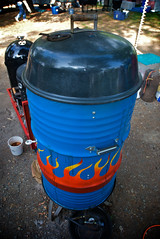Frugal cooking can be an intimidating concept. It’s easy to turn a meal into a huge expense, but it’s not that hard to trim your grocery budget without sacrificing variety and flavor. It just takes some planning and a few money-saving techniques. We usually feed our family of five, often with guests, for about $100 per week.
Schedule your meals. Find or make a weekly meal planner. I recommend this or this. Cross out the meals you don’t need to worry about due to your schedule that week. If you won’t be home, you don’t have to cook that meal. Fill in the meals in the remaining slots. Keep your schedule in mind. If you get home from work at 5:30 and have to be somewhere by 6:30, dinner needs to be something quick. Also, make sure you include every side dish you will be serving. Now, look at the recipe for each dish in every meal. Write down everything you need to make all of the food you plan to eat that week. While planning your meals, think about how to use your leftovers. If you cook chicken breasts one day, the leftovers can be chicken nuggets the next.
Take inventory. Take your meal plan and a pen while you look through all of your cabinets and your refrigerator. Why buy what you already have? If you already have steaks in the freezer, don’t waste your money buying more. If you have it, cross it off of your meal plan shopping list. Whatever is left is your shopping list. Review it. Is there anything that can be combined or eliminated? Is there a key ingredient for a sauce that’s missing?
Don’t forget the staples. If flour or sugar is on sale, stock up. Anything you use on a regular basis is a staple, buy it when it’s cheap.
Build a shopping list from your meal plan. When you are in the store, stick to your list. It’s hard, but avoid impulse purchases at all costs. Don’t shop hungry, don’t buy things just because they are on sale, and don’t dawdle. Get what you need and get out.
Avoid pre-processed food. We slice and shred our own cheese. Buying the pre-shredded cheese costs an extra $5 and saves just 5 minutes. Don’t buy pre-sliced apples or anything that will only save a few minutes for several dollars of cost.
Every couple of weeks, I cook a large pot of either beans or rice and keep it in the refrigerator. Almost every meal that we cook gets a cup or two of beans or rice added to it. It doesn’t alter the flavor much, but it adds a few extra servings for pennies. It’s a healthy way to stretch any meal on the cheap.
We have a large bowl in the refrigerator filled with mixed greens. We buy whatever salad-like greens are on sale and prepare the large salad all at once. Most meals start with a salad, which makes it easier to fill up without relying on the protein dish, which is generally the most expensive part of a meal. As a dedicated meat-eater, it took some getting used to, but it’s a good meal–cheap and healthy.
Cook enough for at least 3 meals. That will eliminate 2/3 of the work involved in cooking. Plan ahead to make your meals simple and easy.
Freeze the leftovers in usable sizes. Stock up on semi-disposable meal-sized containers. Freeze some in single-serving sizes for work, and others in family-size servings for last minute meals at home. Preparing for last minute meals keeps you from serving garbage or takeout when life gets in the way of your plans.
Avoid wasting leftovers. Wasted food is wasted money.
When you are done cooking meat, take any drippings or scraps and throw them into the slow-cooker along with any vegetable scraps laying around. Cook it overnight, then strain it into an ice cube tray. You now have stock/broth ready to be added to any recipe.
Plan for serial meals. Chicken breast leftover from today’s meal can become chicken nuggets tomorrow, to be shredded into chicken salad the next day.
When there isn’t enough left for a full serving, we put the remains in a resealable bag in the freezer. When we accumulate enough to fill our slow-cooker, we dump in all of the bags with a couple cups of water. I look through the refrigerator for any leftovers that have been overlooked that week or any vegetables getting close to being too old. It all gets cut up and added to the cooker to cook on low all day. I rarely add seasoning because everything going in the pot tastes good. We never get the same meal twice and our “free soup” is never bland.
That’s how we cook cheap, without sacrificing too much time. How do you save money cooking?
This post is a blast from the past. Originally posted here in January 2010.








